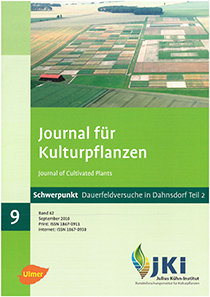Development of weed infestation depending on crop rotation and herbicide intensity
DOI:
https://doi.org/10.5073/JfK.2010.09.01Keywords:
Weed, herbicide, herbicide reduction, crop rotation, weed floraAbstract
There are many factors responsible for the development of weed infestation. Direct weed control, mainly with herbicides, plays an important role, but other factors (e.g. crop rotation) are also relevant for weed development. Based on weed surveys performed at the beginning of long-term field trials in Dahnsdorf, Germany, we compared changes in weed development over time. Two farm types (cash and fodder crops) were assessed separately. In both farm types, two herbicide intensities were used, namely, 50% and 100% of the situation related herbicide dosage. The treated herbicide intensity variants were compared to untreated variants.
Beyond the normal annual fluctuations in weed occurrence, clear differences between the treated and untreated variants were observed. In cash crops, the number of dicotyledonous weeds was, respectively, 187/m2 and 178/m2 in the untreated 50% and 100% variants compared to 128/m2 and 89/m2 in the treated 50% and 100% variants during the second crop rotation (2003–2008). The fodder system had lower levels of weed infestation. During the same period, the number of dicotyledonous weeds was, respectively, 127/m2 and 124/m2 in the untreated 50% and 100% variants and 98/m2 and 62/m2 in the treated 50% and 100% variants. The weed flora also changed during the experiment. Viola arvensis was initially dominant, but the numbers of Matricaria spp. increased steadily. Centaurea cyanus occurrence was limited to the second rotation in the cash crop system.
Downloads
Published
Issue
Section
License
The content of the journal is licensed under the Creative Commons Attribution 4.0 License. Any user is free to share and adapt (remix, transform, build upon) the content as long as the original publication is attributed (authors, title, year, journal, issue, pages).
The copyright of the published work remains with the authors. The authors grant the Journal of Cultivated Plants, the Julius Kühn-Institut and the OpenAgrar repository the non-exclusive right to distribute and exploit the work.







